Auto Insurance
Nearly 3 in 4 Drivers Are Anxious About Driving During Wintry Weather, and 1 in 7 Aren't Confident at All
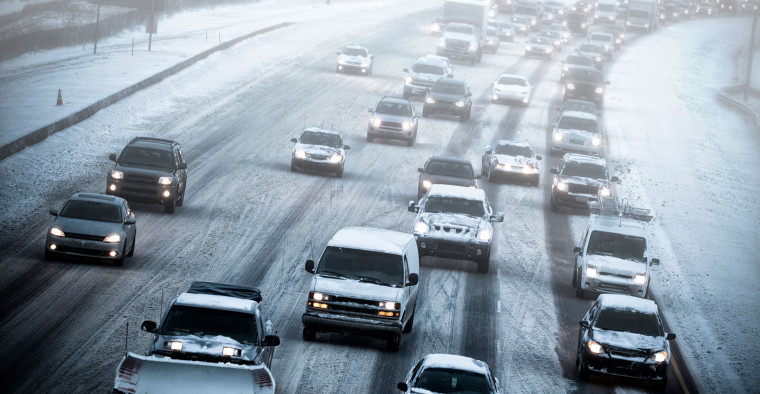
A substantial percentage of drivers (73%) voiced anxiety or fear about driving in bad wintry weather such as snow, sleet or ice, according to the latest ValuePenguin survey. In fact, just 43% of drivers were very confident about driving in these conditions.
Our survey of nearly 1,100 licensed drivers shows women were nearly three times as likely as men to say they weren't at all confident in their ability to drive in snowy or icy conditions. Meanwhile, Gen Zers felt the most anxiety about driving in poor conditions — 10 percentage points higher than the next most anxious age group, in fact.
A contributing factor to the lack of confidence is a lack of preparation. Our survey revealed that few people properly maintain their cars for slick conditions by checking their tire pressure and tread. Further, 48% don't think that they got a full education about driving in bad weather.
Key findings
- 73% of drivers get anxious or scared driving in bad wintry weather conditions. Gen Zers (84%), women (80%) and those living in the Northeast (76%) feel the most anxiety.
- Nearly a quarter of women (23%) say they’re not at all confident in their ability to drive when there is snow or ice on the road. That’s nearly triple the rate of men (8%) who said the same.
- Many drivers lack preparation for driving in poor weather conditions. Fifty-seven percent of drivers haven’t checked their tire tread depth in the past two months, 55% don’t check their tire pressure at least monthly and 29% regularly let their gas tank drop below a quarter tank.
- 48% of drivers don’t think they got a full education about how to drive in bad weather. Case in point: 35% of drivers aren’t completely sure what to do if their car starts to skid.
- 1 in 3 drivers has been in a winter weather-related car accident. Separately, a quarter of drivers say their car has been damaged by wintry weather unrelated to an accident.
73% of drivers are anxious about driving in wintry weather, and 15% aren't confident at all
The proportion of unconfident, anxious drivers varies by location, gender and age. While more than 7 in 10 drivers are anxious about driving in wintry conditions, more women expressed disconcertedness about being behind the wheel in snow or ice. Eighty percent of women said driving in winter conditions made them feel anxious, compared with 68% of men.
Nearly a quarter of women (23%) went further and said they're not at all confident in their ability to drive on snow or icy roads. Just 26% described themselves as very confident, a significantly lower proportion than the percentage of men (58%) who were very confident in their driving skills.
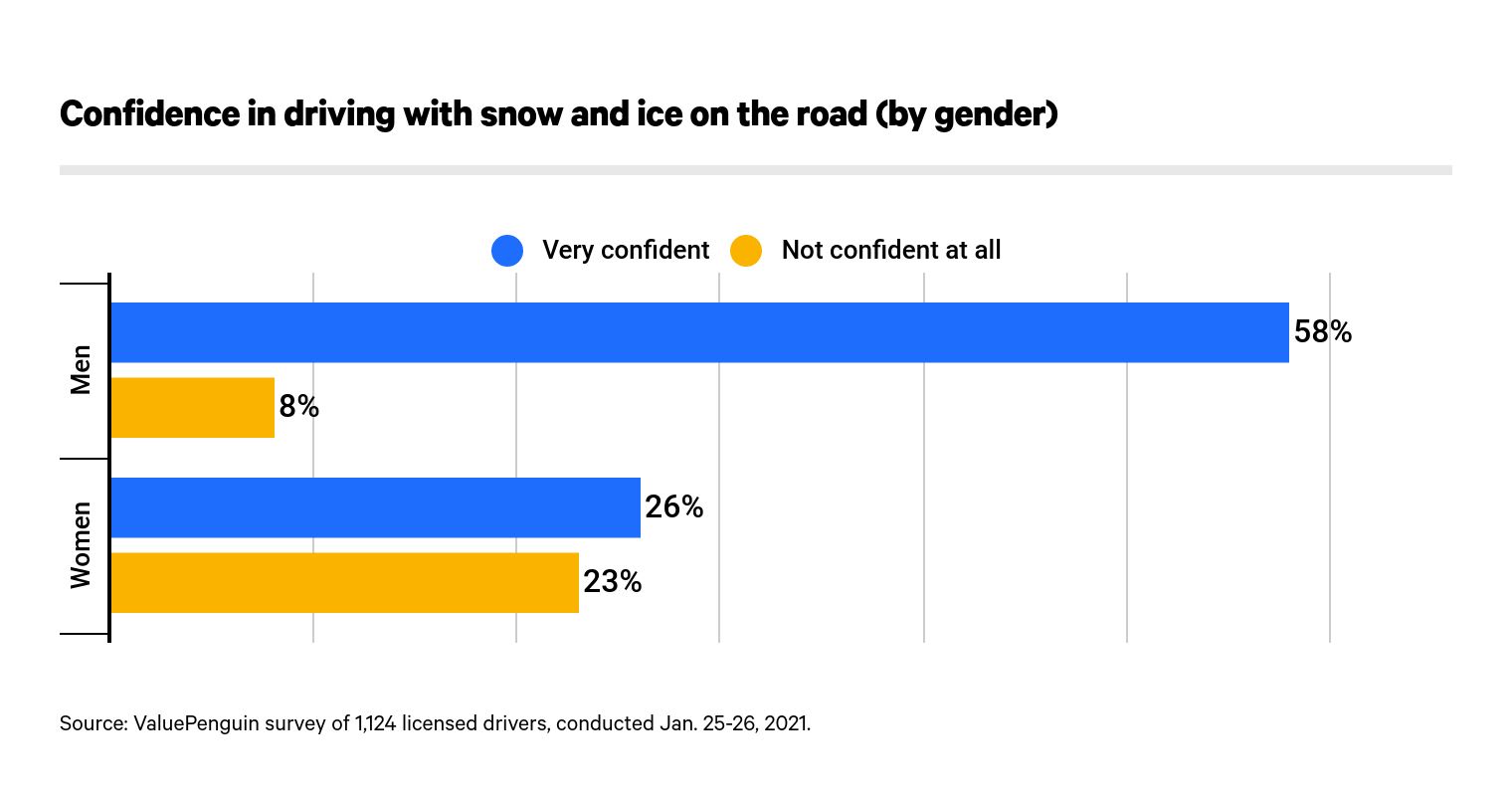
There was a similar disparity across generations. A proportionally higher share of young drivers feels uneasy about driving in bad weather. Wintry weather makes 84% of Gen Z drivers anxious — higher than any other age group by at least 10 percentage points. Following Gen Zers, fewer millennials (74%), Gen Xers (71%) and baby boomers (69%) voiced their anxiety about driving in wintry weather.
Despite these findings, Gen Xers were most likely to not be confident at all about driving in slick conditions. One-fifth of Gen Zers characterized themselves as not confident, compared with just 8% of Gen Zers.
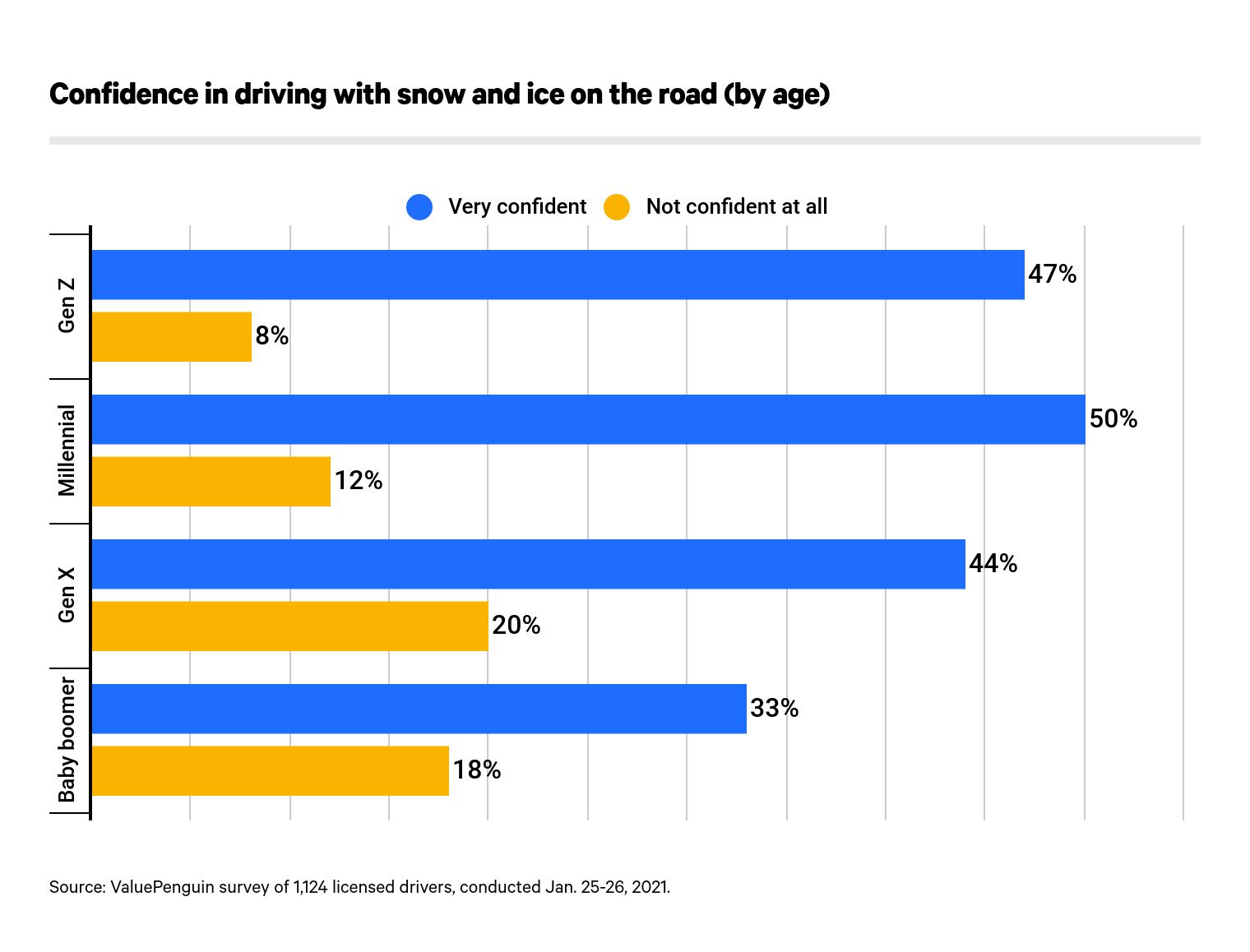
Finally, those living in the Northeast and South were the most likely to feel anxiety about driving in poor conditions. Seventy-six percent of those living in the snowy Northeast said they felt uneasy, though just 8% weren't confident at all they could still drive in bad weather. Seventy-five percent of Southern drivers were anxious about driving in wintry weather, with 22% classifying themselves as completely unconfident.
Unprepared for driving in bad weather, 48% of drivers don't think they were taught enough to feel fully confident in their abilities
Based on responses to our survey, it's clear that a lack of preparedness for wintry weather proliferates among drivers. In fact, 57% of drivers haven't checked their tires' tread depth in the past two months. Keeping a close eye on tire tread is important, as a thick tread depth increases a car's ability to grip the road and stop safely. Dangerously low tread depth contributes to a more uncontrollable vehicle, especially when road conditions are poor.
Less than half of drivers check their tires’ air pressure monthly. It's a good idea to check tire pressure regularly, as cold temperatures — along with the natural wear of driving — can deplete pressure. In fact, 6% can't recall ever measuring their tires' air pressure. As with poor tire tread, driving on low-pressure tires can lead to poor handling and can exacerbate the problems caused by slick roadways.
Wintry weather doesn't only lead to poor driving conditions — it can also negatively affect a vehicle's fuel mileage as the car uses more energy to overcome engine friction and stay warm. As fuel economy falls, drivers are at greater risk of running out of gas mid trip. However, just 19% said they never allow the amount of fuel in their cars to dip below a quarter of a tank. Twenty-three percent drive with less than a quarter in their tanks most of the time, while another 6% almost never fill up until the tank is nearly empty.
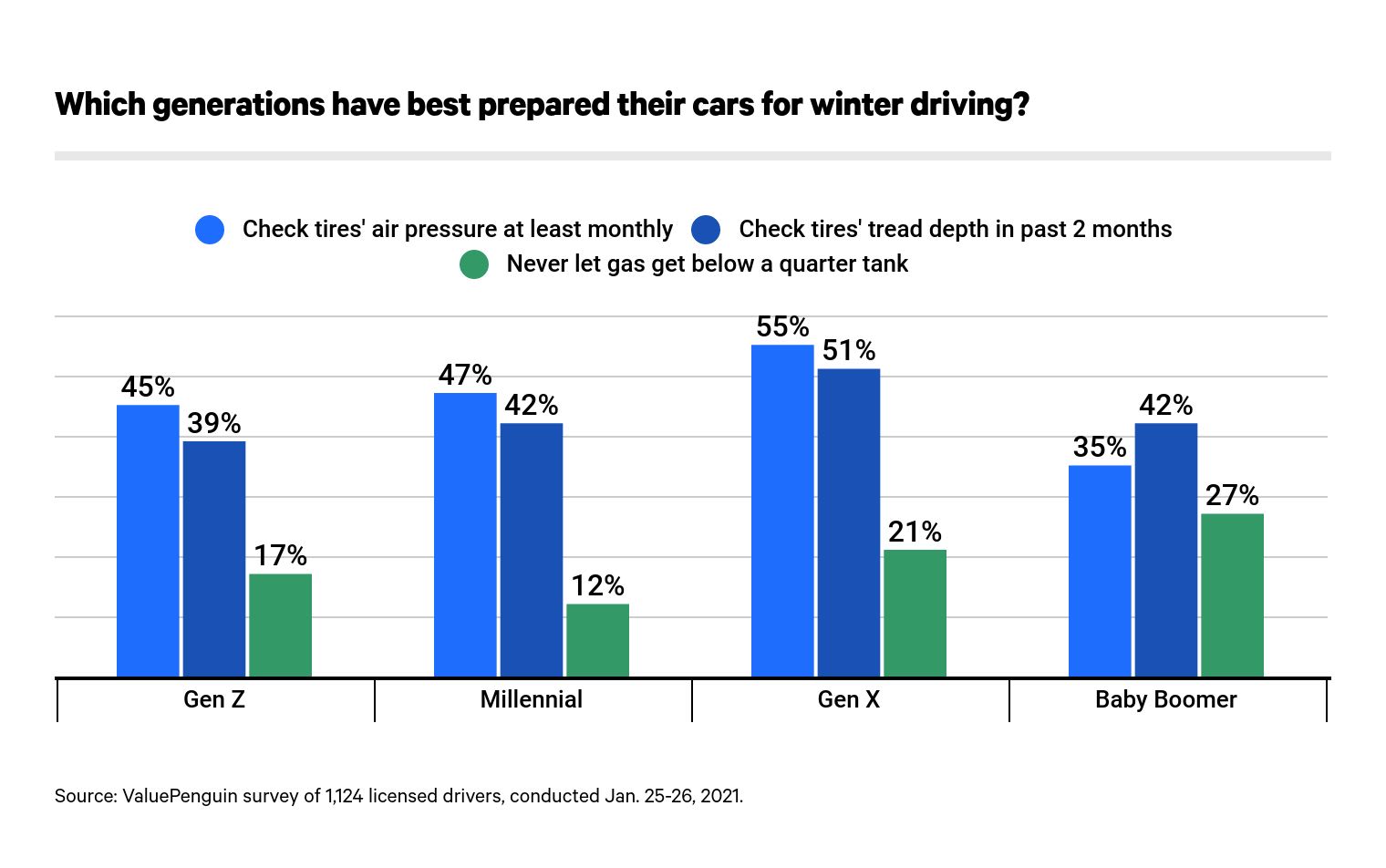
Our data shows that the percentage of drivers who keep their cars stocked with necessities during the winter months varies. While more than half of drivers keep a phone charger (58%), set of jumper cables (54%), ice scraper (54%) and flashlight (51%) on hand, they're less likely to devote space to most items without year-round utility. Fewer than half of drivers carry a snow brush (45%) or blanket (34%), and even fewer stock their cars with snacks and water (29%), extra clothes (18%), a snow shovel (16%) or emergency flares (16%).
These oversights may have ties to education. Forty-eight percent of drivers don't think that they were taught enough about how to properly drive in bad weather. Indeed, 35% of drivers — including 42% of women and 29% of men — aren’t fully sure about what to do if their car starts to skid. And to reduce anxiety while driving in bad weather, 19% pull over and 8% call a loved one despite the danger that these actions can pose on slick roads where visibility is lower than usual.
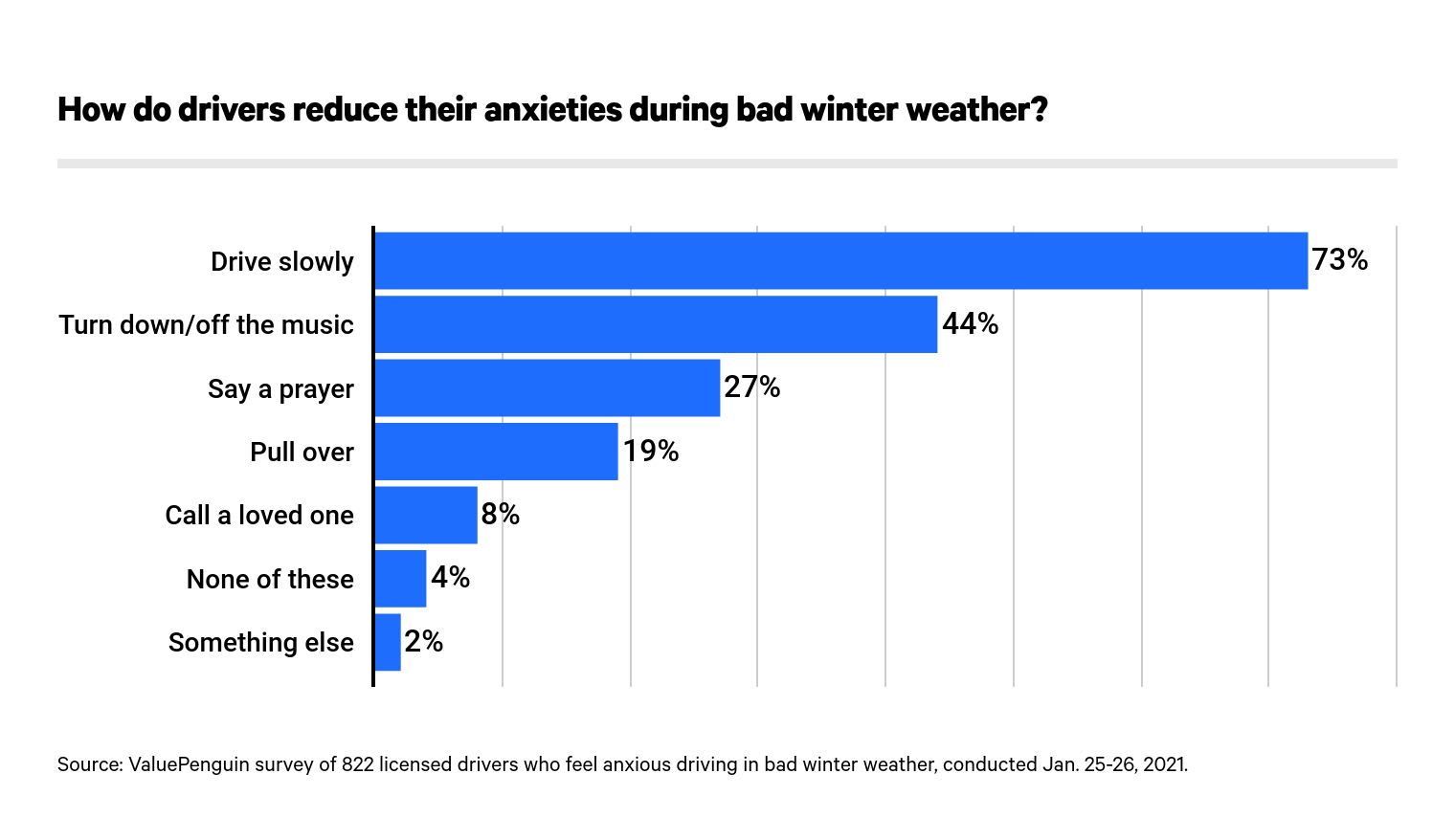
One-quarter of drivers have had their cars damaged by winter weather, but more have been in an accident because of wintry conditions
One-third of drivers reported being involved in an accident that was caused by snow, ice or other wintry weather. Men were more likely than women to have been in an accident, with 38% having experienced a wreck under these circumstances, compared with 27% of women. Forty-three percent of millenials admitted to being involved in crashes, the highest of any demographic.
Of all drivers who have been in an accident, 63% said that other vehicles were involved, while 37% said they were in a single-car accident. Half of all drivers have gotten stuck in the snow before, with 69% of Midwest drivers and 57% of those in the Northeast having found themselves caught in the snow.
When we asked drivers about how their car insurance company had treated their winter-related auto damage, 65% revealed that they were responsible for costs that their insurance providers didn't cover. In fact, just 24% of drivers said their insurer covered all costs. More commonly, policyholders had to pay. While 4 in 10 had to pay less than $1,000 for repairs, 25% were on the hook for more than $1,000. These expenses combined with the cost increase policyholders see following an accident can be significant.
Does car insurance cover winter-driving accidents? Damage caused by winter-driving conditions is covered by the liability portion of a typical car insurance policy when another car strikes your vehicle. If driving conditions cause a single-car crash or damage a vehicle without causing an accident, you would need comprehensive and collision coverage to cover the expenses.
Methodology
ValuePenguin commissioned Qualtrics to conduct an online survey of 1,124 licensed drivers, conducted Jan. 25-26, 2021. The survey was administered using a nonprobability-based sample, and quotas were used to ensure the sample base represented the overall population. All responses were reviewed by researchers for quality control.
We defined generations as the following ages in 2021:
- Generation Z: 18 to 24
- Millennial: 25 to 40
- Generation X: 41 to 55
- Baby boomer: 56 to 75
While the survey also included consumers from the silent generation (defined as those 76 and older), the sample size was too small to include findings related to that group in the generational breakdowns.
